Useimmissa suosituissa sovelluksissa on vikasietotila, jonka avulla käyttäjät voivat suorittaa ohjelmaa rajoitetusti, kun asiat eivät toimi oikein. Näin on Outlookin kanssa - monimutkainen sähköpostinhallinta, joka käyttää vikasietotilaa ohittamaan monet ongelmat, jotka estävät sen käynnistymisen. Voit käynnistää Outlookin vikasietotilassa tarkoituksella, mutta se voi käynnistyä myös tässä tilassa yksin.

Ellet käynnistä vikasietotilaa itse jostain syystä, en suosittele sinua jatkamaan Outlookin käyttöä tässä tilassa. Et voi tallentaa malleja, asetuksia ja et voi käyttää älykkäitä tunnisteita mm. Jos olet tällaisessa tilanteessa, on suositeltavaa käsitellä vikasietotilaa diagnostiikkatyökaluna ja ratkaista ongelma.
Milloin vikasietotilaa käytetään OutLookissa
Outlook päivittää järjestelmärekisterin säännöllisesti, jotta asentamasi uudet laajennukset voivat toimia kuten pitäisi. Jos ohjelma havaitsee käynnistyksen yhteydessä ongelman, joka estää sen suorittamisen, se siirtyy automaattisesti vikasietotilaan . Tämä tapahtuu yleensä heti sen jälkeen, kun olet asentanut uuden lisäosan, joka ei toimi hyvin Outlook-version kanssa.
Voit käynnistää vikasietotilan itse avaamalla Suorita- ikkunan, kirjoittamalla Outlook / turvallinen ja painamalla OK .

Siinä tapauksessa, että Outlook käynnistyy automaattisesti vikasietotilassa , se on yleensä merkki siitä, että jokin ei toimi oikein. Joskus Outlook onnistuu tunnistamaan apuohjelmakomponentin, joka estää Outlookia käynnistymästä normaalisti. Jos se pyytää viallisen komponentin poistamista käytöstä, kokeile sitä ja katso, onnistuuko Outlook käynnistymään normaalisti.

Mahdolliset vikasietotila laukaisee
Jos käytät versiota 2010, ongelmasi johtuu todennäköisesti KB3114409-päivityksestä, joka saa Outlookin käynnistymään vikasietotilassa ja palaamaan oletusasetuksiin. Jos käytät vanhempaa Outlook-versiota, kuten 2007 tai 2003, ongelma saattaa liittyä Windows- hakupalveluun. Väärä apuohjelma voi myös olla ristiriidassa Outlook-version kanssa siinä määrin, että pakotat sen käynnistymään vikasietotilassa .
Nämä ovat vain kolme mahdollista syyllistä, mutta syyt voivat olla peräisin monista paikoista.
Alla on kokoelma korjauksia, jotka ovat jo auttaneet monia käyttäjiä estämään Outlookia toimimasta vikasietotilassa . Seuraa yllä olevia tapoja järjestyksessä Outlook-version mukaan, kunnes löydät korjauksen, joka ratkaisee ongelmasi.
Tapa 1: Apuohjelmien poistaminen käytöstä vikasietotilassa (kaikki Outlook-versiot)
Tämä on yleinen tapaus kaikissa Outlook-versioissa Outlook 2007: stä Outlook 2016: een . Tämä tapahtuu, koska tietyt apuohjelmat ovat ristiriidassa Outlook-version kanssa. Tämä on vielä todennäköisempää vanhentuneiden lisäosien kanssa, jotka on asennettu Outlookin uusimpiin versioihin.
Huomautus: Jos olet asentanut ABBYY FineReader -apuohjelman ennen tämän virheen alkamista, poista lisäosa Outlook-versiosta noudattamalla seuraavia ohjeita.
- Varmista, että Outlook on vikasietotilassa tarkistamalla, onko tehtäväpalkin kuvakkeessa huutomerkki.

Huomautus: Voit vahvistaa myös katsomalla, näkyykö (vikasietotila) näytön yläosassa.

- Laajenna nyt Tiedosto- välilehti ja napsauta Asetukset .

- Napsauta nyt Apuohjelmat- välilehteä. Sieltä pääset avattavaan valikkoon Hallinta -kohdan vieressä ja valitse luettelosta COM-apuohjelmat . Napsauta Siirry jatkaaksesi.
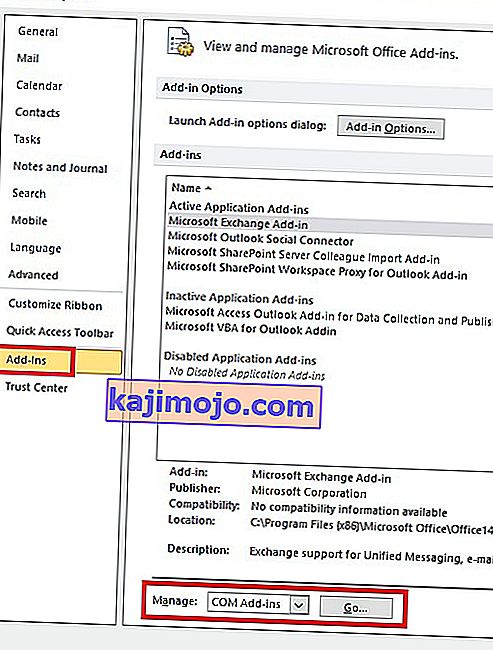
- Tässä vaiheessa sinun tulisi ottaa kuvakaappaus lisäosaluettelosta ja tallentaa se jonnekin kutsuttavaksi. Tämä auttaa palauttamaan Outlookin normaalin kokoonpanon, jos vikoja ilmenee apuohjelmien poistamisen jälkeen.
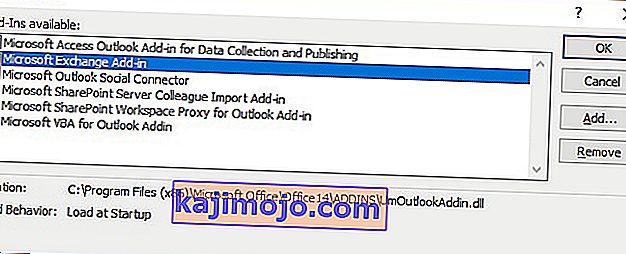
- Poista kaikki merkinnät käytöstä (tyhjennä valitut valintaruudut) ja paina OK .
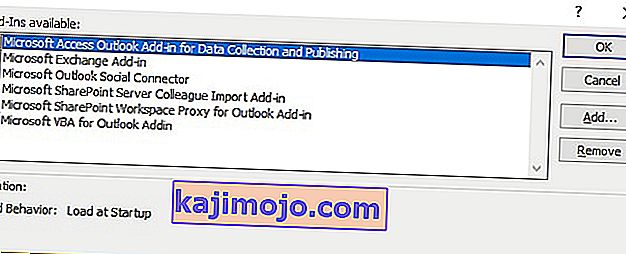 Huomaa: Älä paina Poista-painiketta vielä. Meidän on ensin vahvistettava, että he aiheuttavat ongelman.
Huomaa: Älä paina Poista-painiketta vielä. Meidän on ensin vahvistettava, että he aiheuttavat ongelman. - Sulje Outlook ja avaa se uudelleen. Jos ohjelma käynnistyy normaalitilassa, ongelma on ratkaistu.
Huomaa: Jos se käynnistyy edelleen vikasietotilassa , siirry kohtaan Tiedostoasetukset> Apuohjelmat ja ota uudelleen käyttöön apuohjelmat, jotka poistimme käytöstä vaiheessa 5, ja siirry tapaan 2 .
- Palaa kohtaan Tiedosto> Vaihtoehto> Apuohjelmat ja ota kukin apuohjelma järjestelmällisesti uudelleen käyttöön yksitellen, kunnes paljastat ristiriitoja aiheuttavan.
- Valitse se ja paina Poista .
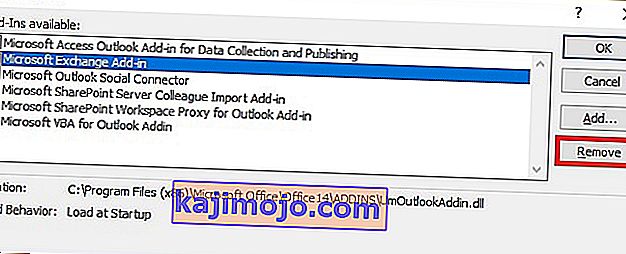
- Käynnistä Outlook uudelleen ja tarkista, käynnistyykö se normaalitilassa.
Tapa 2: Palauta tietokoneesi järjestelmän palauttamisen avulla (kaikki Outlook-versiot)
Järjestelmän palauttaminen on Windows-ominaisuus, jonka avulla käyttäjät voivat palauttaa tietokoneen tilan edelliseen ajankohtaan. Tämä palvelee tarkoitustamme, jos voimme palata tilaan, joka edeltää sitä, missä Outlook alkoi toimia väärin. Tee näin:
- Pidä Windows-näppäin ja paina R. Type rstrui.exe ja klikkaa OK .
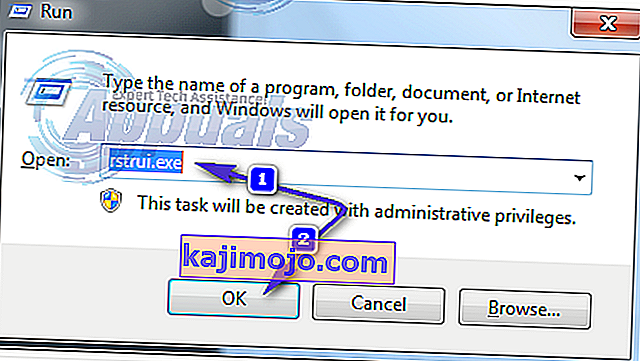
- Vuonna Järjestelmän palauttaminen -ikkuna, valitse Valitse toinen palautuspiste ja osui Seuraava.
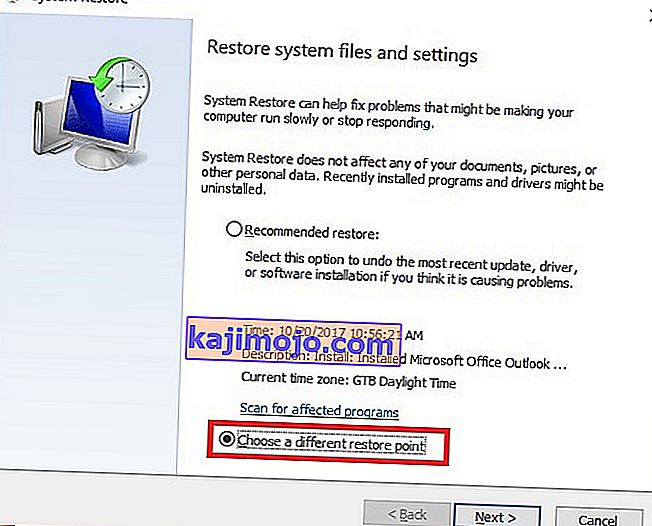
- Paksu ruutu Näytä lisää palautuspisteitä -kohdan vieressä .
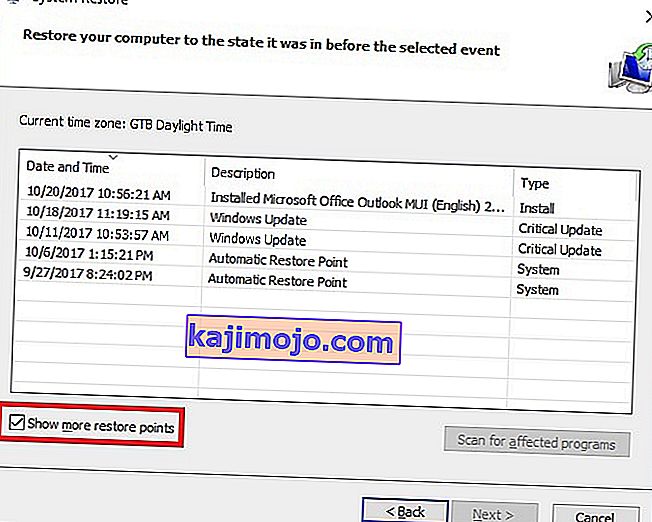
- Etsi piste, kun Outlook toimi, valitse sitten se palautuspiste ja jatka näytön ohjeiden mukaisesti palauttaaksesi tietokoneen aikaisempaan aikaan.
- Kun tämä on tehty, järjestelmä alkaa palauttaa. Kun palautus on valmis, tarkista, toimiiko Outlook. jos ei, jatka tapaan 3 .
Tapa 3: Palauta Outlookin edellinen versio
Jos työpöydän käyttöjärjestelmän palauttaminen aikaisempaan versioon ei onnistunut, yritetään palauttaa Outlook edelliseen versioon. Näin:
- Napsauta Käynnistä-painiketta ja kirjoita hakuikkunaan Outlook.exe . Napsauta sitä hiiren kakkospainikkeella ja valitse Ominaisuudet .
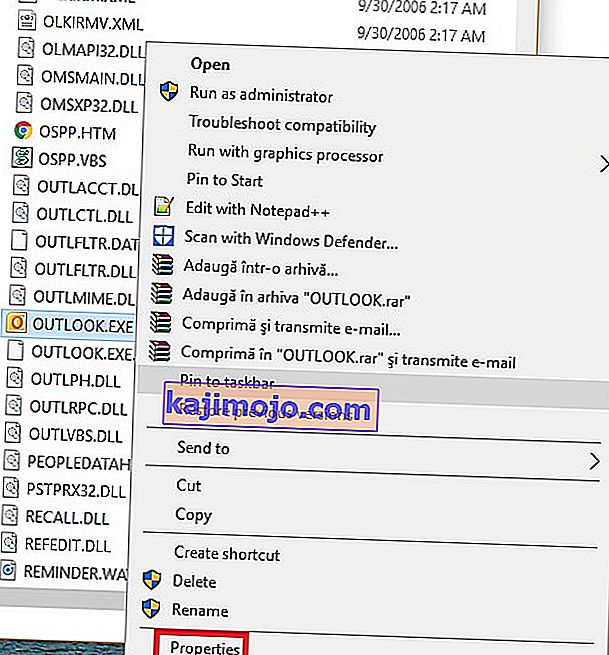
- Siirry sitten Edellinen versiot -välilehdelle ja etsi Outlook.exe- tiedosto, jolla on päivämäärä, jolloin se toimi. Napsauta Avaa nähdäksesi, toimiiko se ja avautuuko se ilman vikasietotilaa .
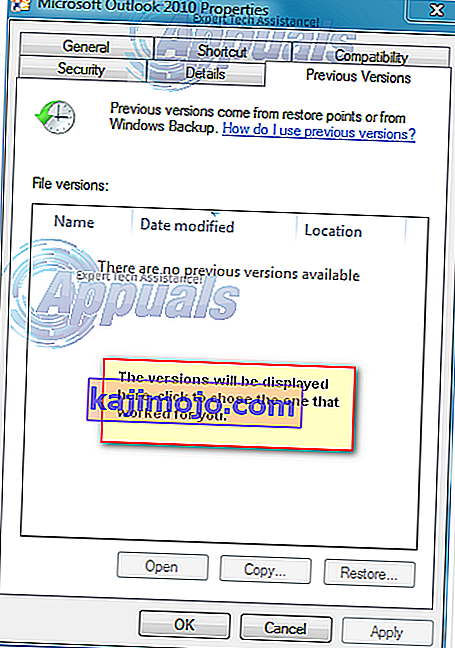 Note: Make sure the non-working Outlook that previously opened in Safe Mode is closed because we are now running one of the copies saved in the previous versions. Do the same for all versions listed there. Open/Close until you see the one that opens without Safe Mode. If it does work, then keep the Window open.
Note: Make sure the non-working Outlook that previously opened in Safe Mode is closed because we are now running one of the copies saved in the previous versions. Do the same for all versions listed there. Open/Close until you see the one that opens without Safe Mode. If it does work, then keep the Window open. - Assuming that you now have the version of Outlook running, without Safe Mode from one of the previous versions. Hold the Windows Key and Press R. Type taskmgr and click OK.
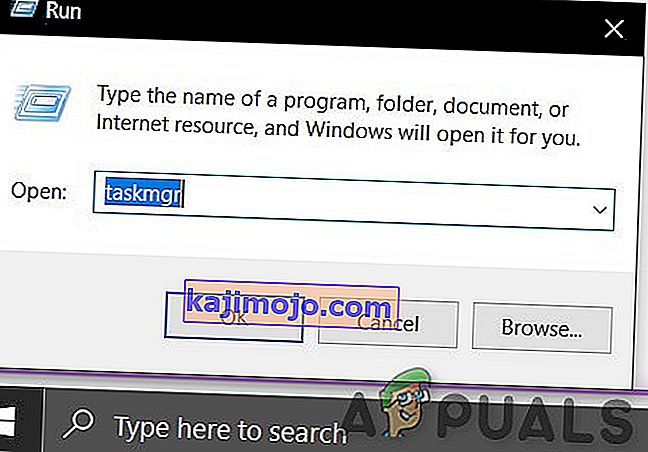
- In the Task Manager Window, Go to the Process Tab, locate Outlook.exe, right-click on it and choose Open File Location.
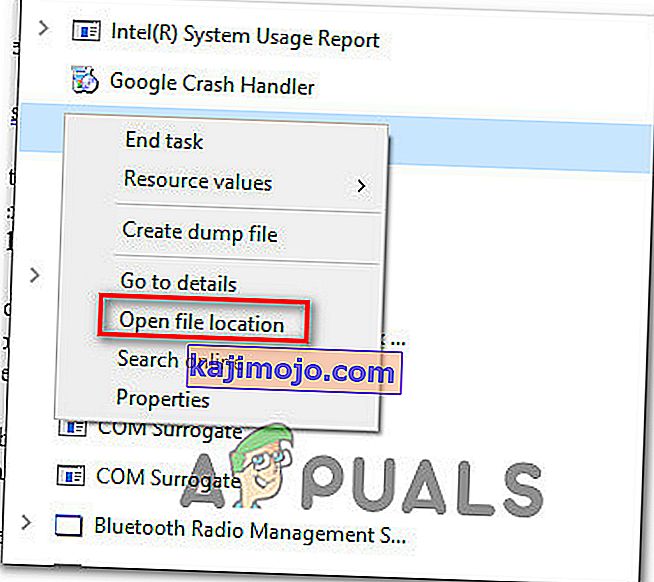
- Copy all the files from the next window, then navigate to C:\Program Files (x86)\Microsoft Office\Office. Paste the filed previously copied here.
- Try to re-open Outlook and see if it starts in normal mode.
Method 4: Uninstalling the KB3114409 update ( Outlook 2010)
Sometime in 2015, Microsoft issued a security patch that caused Outlook to run in Safe Mode and revert it back to the default configuration. The user-made configurations aren’t lost forever and will be back when Outlook manages to boot up in normal mode.
If you have this problem, there are two ways to proceed forward. Since Microsoft issued an update that fixes the problem caused by KB3114409, we can install that over the bad update. A different route would be to simply uninstall the KB3114409.
We highly recommend you to go for installing the official Microsoft update fix. But regardless of which option you opt for, we will guide you through the whole process.
Using the official Microsoft fix
Microsoft update KB3114560 was issued specifically to fix the damage done by KB3114409. As a rule of thumb, you should always install security updates from the official website. Here’s what you need to do:
- Access this official link and click on one of the two different update versions, according to your PC specs.
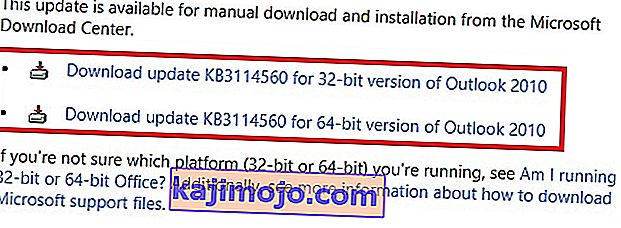
- Select the default language of your Outlook program and click on the Download button.

- Once the update has been downloaded, open the executable and follow through with the installation process.
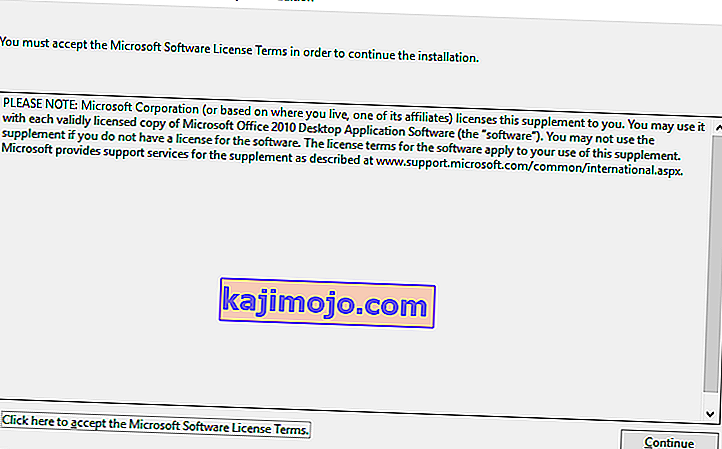
- Restart your PC, open Outlook again and see if the issue has been resolved.
Uninstalling the KB3114409 update
- Close Outlook completely.
- Open Control Panel, click on Uninstall a program.
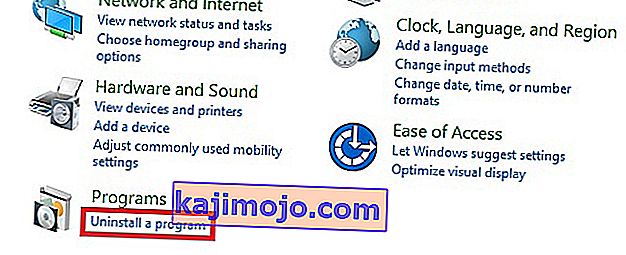
- Once you’re in the Programs and Features window, click on View installed updates.
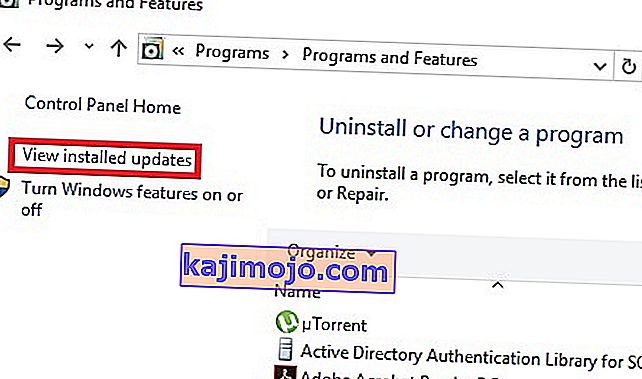
- Use the Search Installed Updates search bar in the top-right corner to search for the bad update (KB3114409 ).

- Once you manage to identify the bad update, click the Uninstall button and follow through with the confirmation prompts.
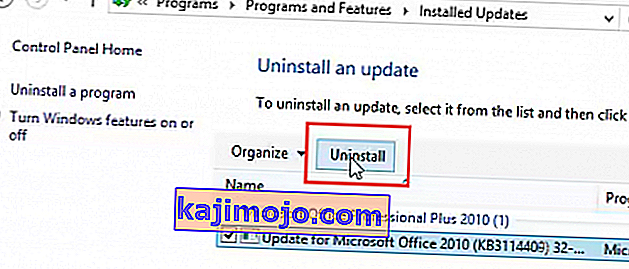
- Restart your PC, open Outlook and see if the issue repeats.
Method 5: Doing an Outlook Profile reset (All Outlook versions)
If you experience hanging at the initial Outlook splash screen (right before it initiates Safe Mode), you might need to do a profile reset. Here’s how to do it:
- Go to Control Panel > Mail and click on Show Profiles.
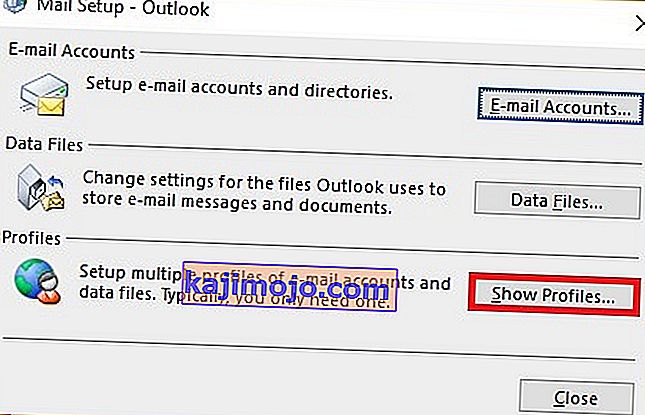
- Now, create a new profile by clicking the Add button. Insert a name and hit OK.
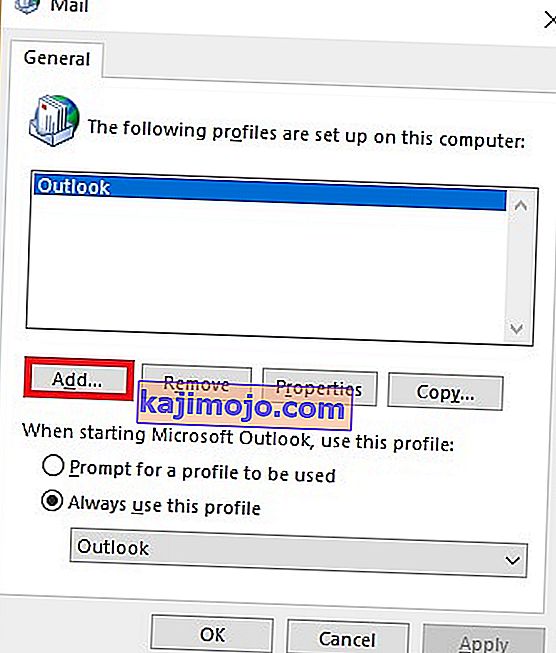
Note: Do not delete the original profile, because we don’t know if this will end up fixing the issue.
- Go through the steps of configuring your email account with Outlook. Make sure to use the same email that you have on the already created profile.
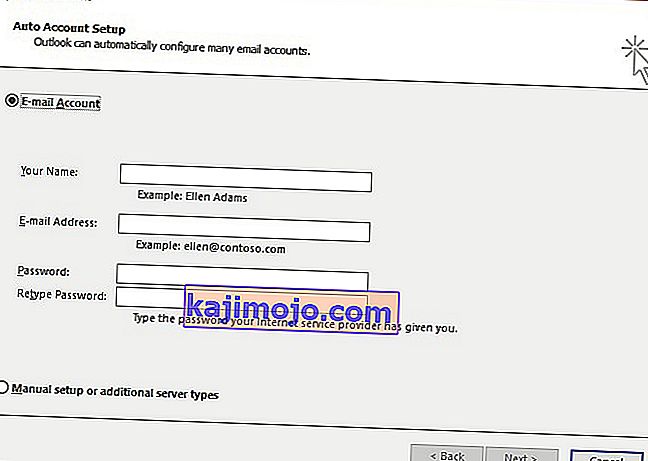
- Now return to the Mail window and make sure the profile you’ve just created is being used by default. Hit Apply to confirm your selection.
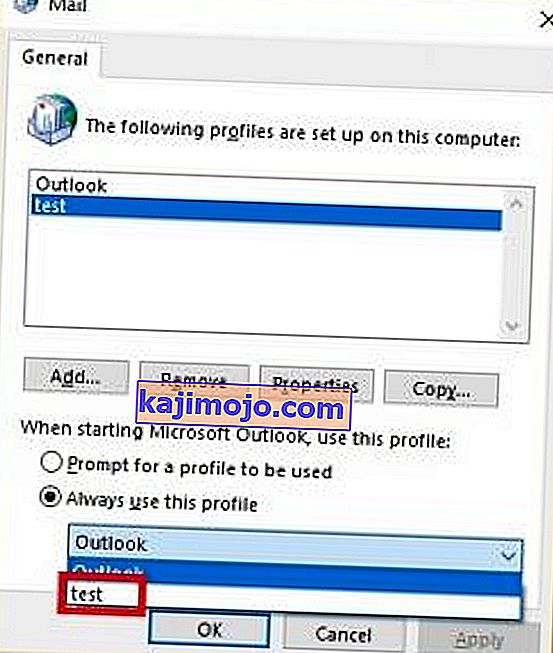
- Start Outlook again and see if it manages to start in normal mode after the profile reset.
Method 6: Checking the PST folder for corruption (All Outlook versions)
Another common cause for Outlook starting in Safe Mode is the Personal Folders File (PST). In the event that it becomes very large, or some files inside are corrupted, it might prevent the program from starting in normal mode. Luckily, you can easily check for corruption by using a Microsoft Repair tool called Scanpst.exe. Here’s what you need to do:
- Close Outlook completely and navigate to C:\ Program Files or C:\ Program Files (x86), depending on which version of Outlook you use.
- Use the search box in the top-right corner to search for SCANPST.exe.
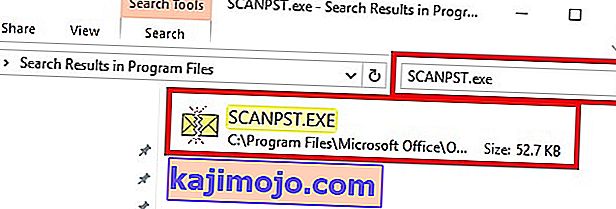 Note: If you don’t manage to find the SCANPST executable via the search bar, you need to navigate to the exact location. Here’s a list of the exact locations based on various Outlook versions:
Note: If you don’t manage to find the SCANPST executable via the search bar, you need to navigate to the exact location. Here’s a list of the exact locations based on various Outlook versions:2016: C:\Program Files (x86)\Microsoft Office\root\Office16 2013: C:\Program Files (x86)\Microsoft Office\Office15 2010: C:\Program Files (x86)\Microsoft Office\Office14 2007: C:\Program Files (x86)\Microsoft Office\Office12
- Open SCANPST.exe and set the path of the PST file you want to scan by using the Browse button. By default, the PST files are stored in Documents\Outlook Files. When you are ready, hit Start to begin the scan.
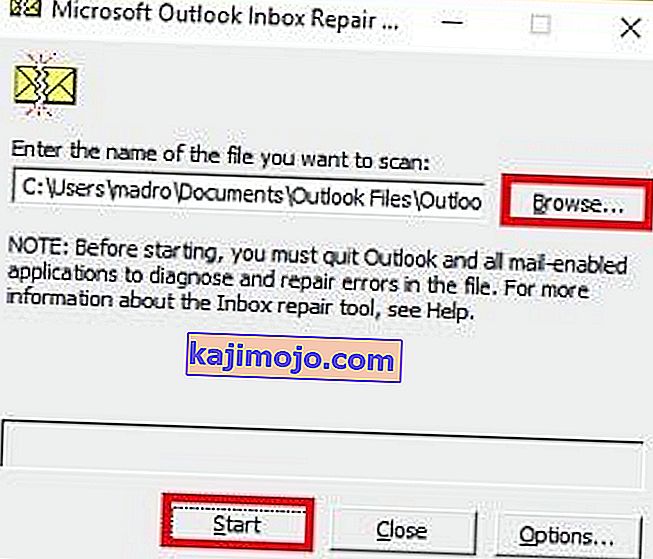
- If the scan uncovers errors or inconsistencies, click on the Repair button to fix them.
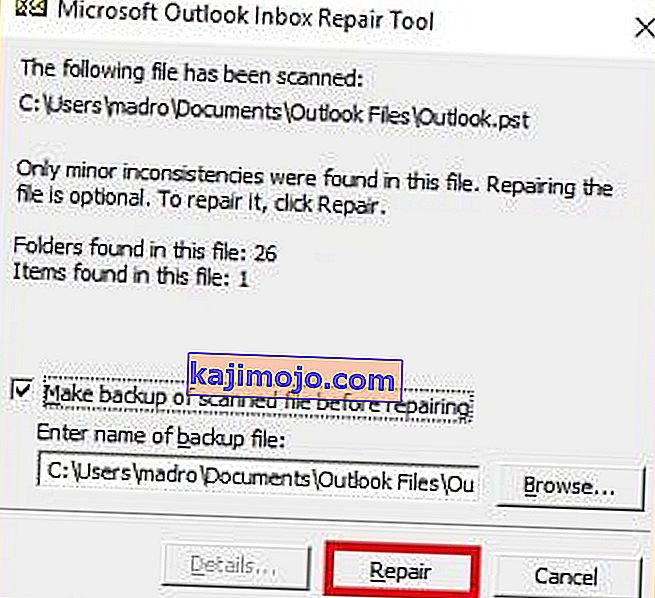
- Once the repair is done, restart Outlook with the profile that you’ve just repaired of errors and see if it starts in normal mode.
Method 7: Running the /resetnavpane command (All Outlook versions)
The navigation pane is that left portion of Outlook where you can oversee your folder list and access various icons to move between calendar, people, tasks, and mails. Sometimes, it can become glitched and prevent Outlook from starting in normal mode. Luckily, there is a command that removes any customizations to the navigation pane and gets rid of any glitch. Even better, this is done outside Outlook with ease. Here’s how:
- Close Outlook completely.
- Go to Start and access the Run application.
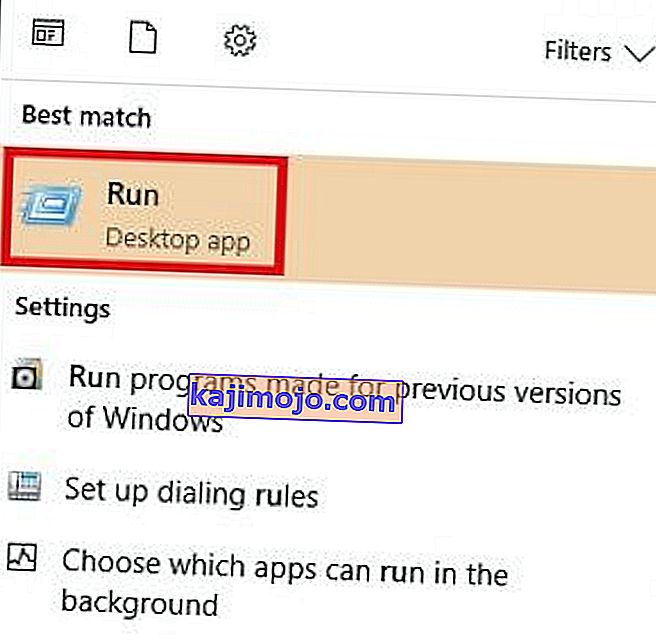
- Now, type Outlook.exe /resetnavpaneand hit OK.
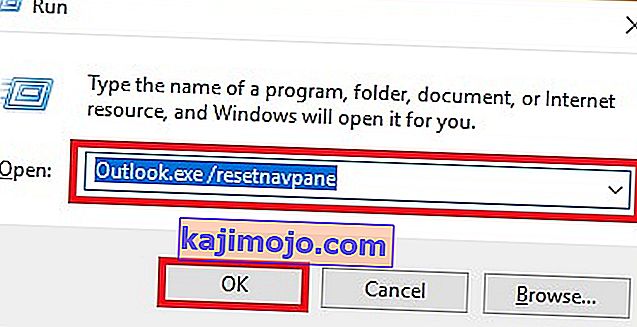 Note: Keep in mind that any customization to the navigation pane will be lost after you click on OK.
Note: Keep in mind that any customization to the navigation pane will be lost after you click on OK. - Shortly after, Outlook should automatically open in normal mode.
Method 8: Disabling compatibility mode
A lot of users have reported that they managed to start Outlook in normal mode after finding out it was running in compatibility mode. Compatibility mode is designed to help a program run as if it was running on an older operating system. As it turns out, turning off compatibility mode might just fix your Outlook Safe Mode problem. Here’s how:
- Close Outlook and navigate to the Outlook.exe on your computer. The exact path of it will differ, depending on your Outlook version. Here’s a list of the exact paths depending on your Outlook version:
2016 - C:\Program Files (x86)\Microsoft Office\root\Office16 2013 - C:\Program Files (x86)\Microsoft Office\Office 15 2010 - C:\Program Files (x86)\Microsoft Office\Office 14 2007: C:\Program Files (x86)\Microsoft Office\Office12

- Right-click on Outlook.exe and click on Properties.
- Now click on the Compatibility tab and make sure the box directly under Compatibility Mode is unchecked. Hit Apply to confirm your selection.
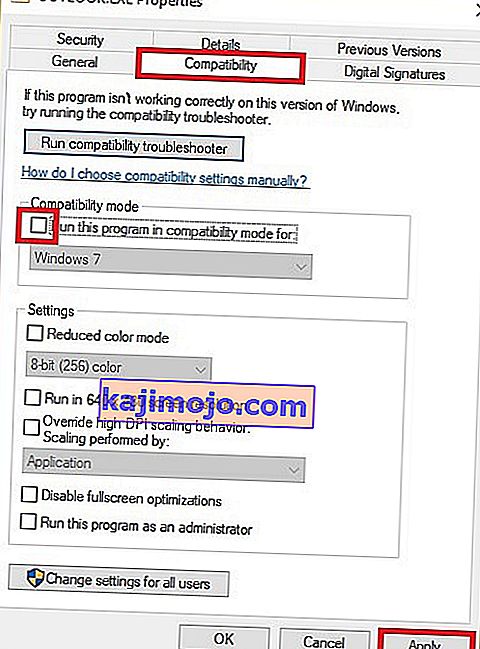
- Finally, open Outlook from the same Outlook executable and see if it manages to start in normal mode.
Method 9: Disabling hardware acceleration (All Outlook versions)
As it turns out, Outlook tries to use hardware acceleration whenever it can to make things as seamless as possible. If you’re Outlook forces itself into Safe Mode, it could very well be an issue with hardware acceleration. We can check to see if that’s the case by making some minor tweaks inside regedit. Here’s how:
- Go to Start and open the Run application.
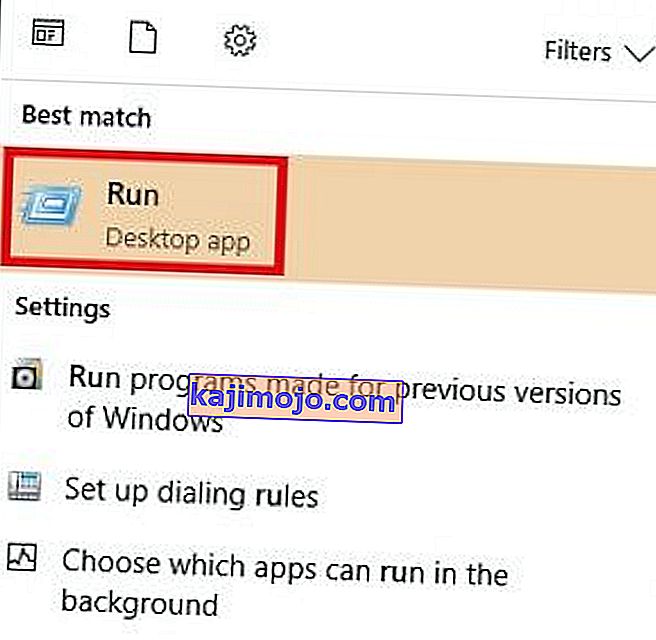
- Search for regedit and click OK to open the Registry Editor.

- Navigate your way to the following location
HKEY_CURRENT_USER\ Software\ Microsoft\ Office.
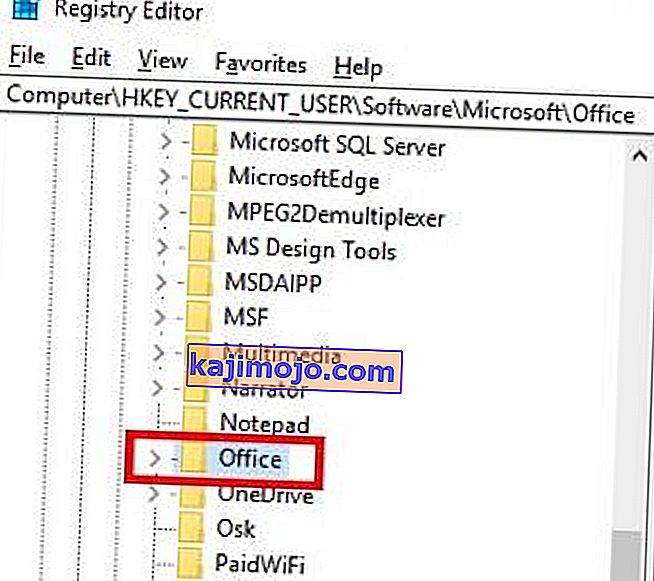
- Now, depending on which Outlook version you have, you might encounter different folders. You should either see a folder named 14.0, 16.0 or 8.0. Either way, click on the folder and double-click on the Common folder.
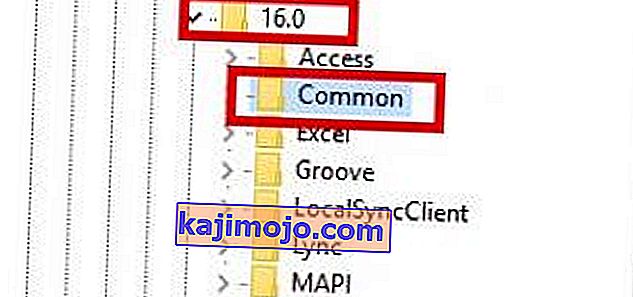
- Right-click anywhere in the Common folder, select New and click on Key and name it Graphics.
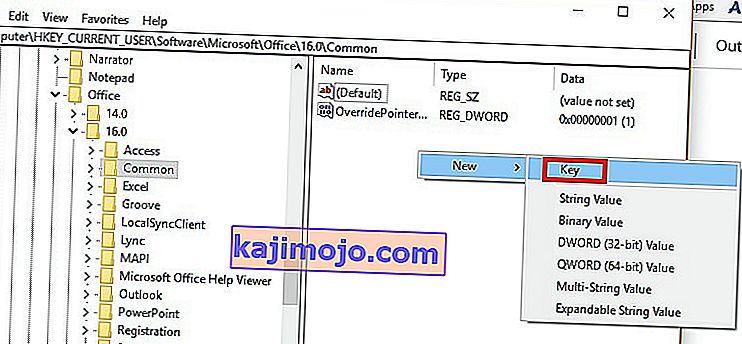
- Select the newly created Graphics folder and right-click on the right panel. From there, create a New Dword (32-bit) Value and name it DisableHardwareAcceleration.
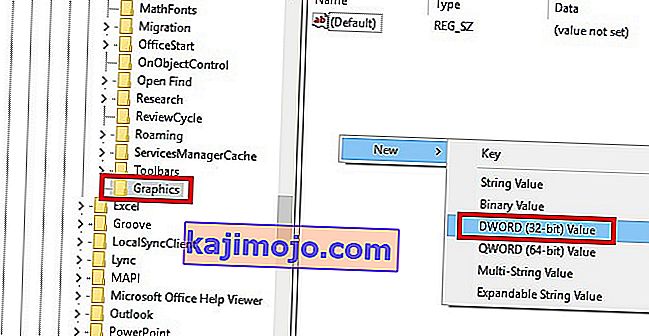
- Now double-click on DisableHardwareAcceleration and set the Value Data to 1 and hit Ok.
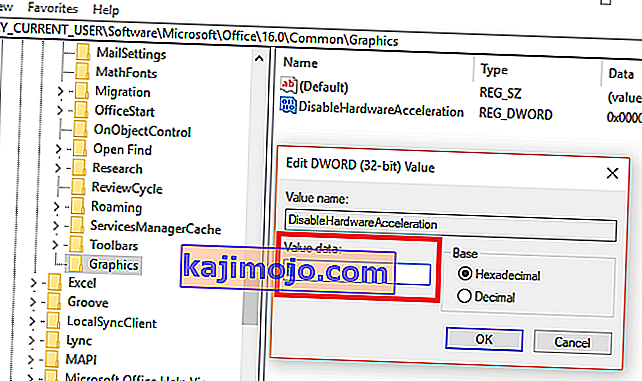
- Close regedit and open Outlook again to see if it starts in normal mode.
Method 10: Resetting the Safe Mode Registry Key (Outlook 2010)
If you have unsuccessfully followed all the methods above, there’s one more thing you can try. A final solution would be to try and prevent Safe Mode from kicking in by tweaking the registry key. But keep in mind that after you’ll follow the steps below, you won’t be able to use Safe mode in the future. At least not until you remove the key that we will create. Here’s what you need to do:
- Go to Start and open the Run application.

- Search for regedit and click OK.

- Navigate your way through HKEY_CURRENT_USER\ Software\ Microsoft\ Office.

- Now, depending on which Outlook version you have, you might encounter different folders. You should either see a folder named 14.0, 16.0 or 8.0. Either way, click on the folder navigate further to Outlook \ Security.
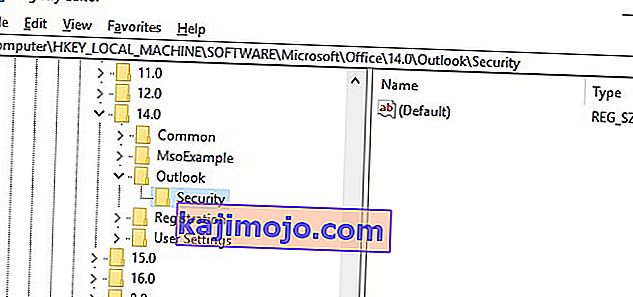 Note: If the Security folder is missing, Right-click > New > Key and type Security.
Note: If the Security folder is missing, Right-click > New > Key and type Security. - Right-click on the Security key and choose New > then DWORD (32-bit) Value.
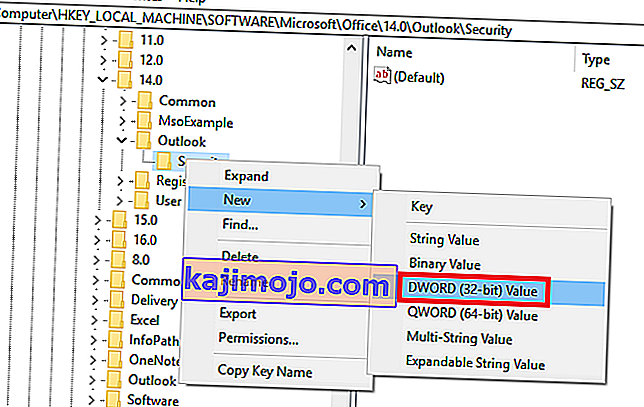
- Name it DisableSafeMode and press Enter to confirm.
- Right-click on DisableSafeMode and click on Modify.
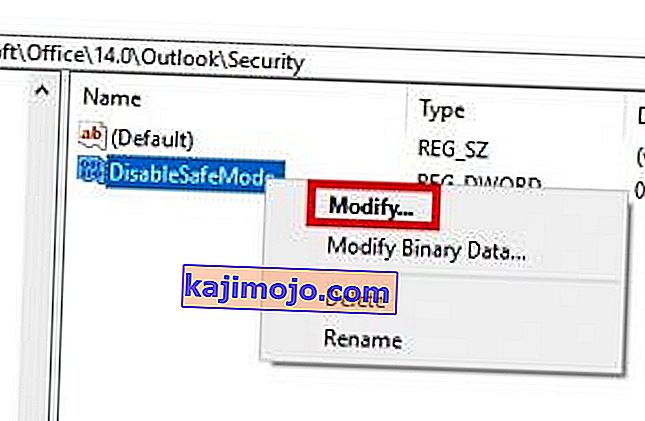
- Aseta arvo 1 on Arvon data -ruutuun ja valitse OK .

- Sulje Rekisterieditori ja käynnistä tietokone uudelleen.
- Avaa Outlook ja katso, käynnistyykö se normaalitilassa.






 Huomaa: Älä paina Poista-painiketta vielä. Meidän on ensin vahvistettava, että he aiheuttavat ongelman.
Huomaa: Älä paina Poista-painiketta vielä. Meidän on ensin vahvistettava, että he aiheuttavat ongelman.




 Note: Make sure the non-working Outlook that previously opened in Safe Mode is closed because we are now running one of the copies saved in the previous versions. Do the same for all versions listed there. Open/Close until you see the one that opens without Safe Mode. If it does work, then keep the Window open.
Note: Make sure the non-working Outlook that previously opened in Safe Mode is closed because we are now running one of the copies saved in the previous versions. Do the same for all versions listed there. Open/Close until you see the one that opens without Safe Mode. If it does work, then keep the Window open.












 Note: If you don’t manage to find the SCANPST executable via the search bar, you need to navigate to the exact location. Here’s a list of the exact locations based on various Outlook versions:
Note: If you don’t manage to find the SCANPST executable via the search bar, you need to navigate to the exact location. Here’s a list of the exact locations based on various Outlook versions:


 Note: Keep in mind that any customization to the navigation pane will be lost after you click on OK.
Note: Keep in mind that any customization to the navigation pane will be lost after you click on OK.








 Note: If the Security folder is missing, Right-click > New > Key and type Security.
Note: If the Security folder is missing, Right-click > New > Key and type Security.

